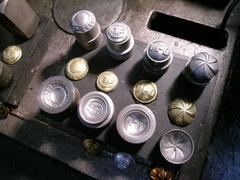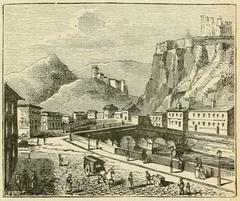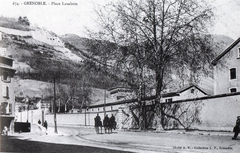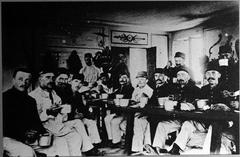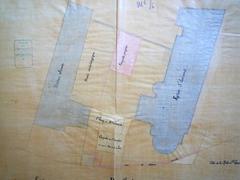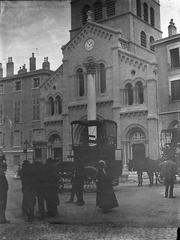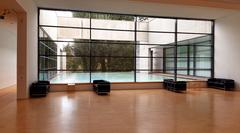
Grenoble Bastille Cable Car: Complete Visiting Guide for 2025
Introduction
The Grenoble-Bastille Cable Car, affectionately known as “Les Bulles” (“The Bubbles”) for its distinctive spherical cabins, is not only one of Grenoble’s most iconic historical sites but also a pioneering example of urban cable transport. Since 1934, it has connected the city’s vibrant center with the historic Bastille fortress, perched atop Mount Rachais. This cable car journey offers breathtaking panoramic views of the Isère valley and the French Alps, blending technology, history, and natural beauty into a singular visitor experience (Bastille-Grenoble; Grenoble Tourisme; Auvergne-Rhône-Alpes Tourisme).
This comprehensive guide details the cable car’s history, technical evolution, visiting hours and ticket options, accessibility features, highlights at the Bastille fortress, and practical travel tips—ensuring you make the most of your visit to this must-see Grenoble landmark (Trek Zone; TripHobo; Bastille Grenoble FAQ; francevoyager.com).
Historical Overview
Origins and Vision
The idea for an urban cable car in Grenoble emerged in the 1920s, driven by the city’s ambition to highlight its alpine setting and modernize its infrastructure. Mayor Paul Mistral, inspired by the 1925 International Exposition of Hydropower, played a pivotal role in advancing this vision, alongside Paul Michoud, then vice-chairman of the local chamber of tourism (Wikipedia). The Bastille fortress, a 19th-century military stronghold overlooking Grenoble and the Isère valley, was chosen for its strategic location and panoramic views.
When the cable car opened on September 29, 1934, it was among the world’s first urban cableways, following those in Rio de Janeiro and Cape Town (Bastille-Grenoble; Auvergne-Rhône-Alpes Tourisme).
Technical Evolution
- 1934–1951: The original dodecagonal cabins, designed by Jean Benoit, each carried 15 passengers. Distinctive lower and upper stations reflected the architectural style of the era (Grenoble Tourisme).
- 1951–1976: The post-war period saw the introduction of larger, rectangular metal cabins and a renovated lower station (1959) to accommodate increased demand (Bastille-Grenoble).
- 1976–Present: The debut of the transparent “bubble” cabins, designed by Denis Creissels and Pomagalski (now Poma), marked a new era. Each cabin holds up to six people and provides 360-degree views, quickly becoming a beloved city symbol (Grenoble Tourisme; Auvergne-Rhône-Alpes Tourisme).
The cable car now serves over 260,000 visitors annually and operates for nearly 4,000 hours each year (OnPiste; Auvergne-Rhône-Alpes Tourisme).
Renovations and Sustainability
In the 2000s, major renovations improved station accessibility and safety (Grenoble Tourisme). Modernization continued with new safety systems (2016) and a green-painted bubble (2022) to celebrate Grenoble’s status as European Green Capital (Bastille-Grenoble). The cable car’s commitment to sustainability is reflected in its all-electric, low-emission operations and eco-friendly station designs (RTGB Official Site).
Visiting the Grenoble-Bastille Cable Car
Operating Hours (2025)
- Winter (Nov–Mar): 9:30 AM – 5:00 PM
- Spring/Fall (Apr, Oct): 9:30 AM – 6:00 PM
- Summer (May–Sep): 9:30 AM – 10:00 PM
Extended hours may apply during holidays and special events. Always check the official website before your visit.
Ticket Information
- Adult Round-Trip: €9.60
- Adult One-Way: €6.50
- Children (5–15 years) Round-Trip: €5.00
- Children (5–15 years) One-Way: €3.60
- Children under 5: Free (with family)
- Discounts: Available for students, seniors (75+), people with disabilities, and families (Bastille Grenoble FAQ; bastille-grenoble.fr)
Tickets can be purchased at the lower and upper stations or online. The digital G-PASS is available for contactless entry and package deals (Grenoble Tourism Portal).
Practical Information
- Location: Quai Stéphane Jay, in the city center near Jardin de Ville
- Transport: Accessible by foot, tram, bus, and with nearby paid parking
- Departure Frequency: Cabins depart every 5–7 minutes; the ride lasts about 5 minutes
- Pets: Dogs allowed with a €2.40 fee (muzzle required for some breeds)
- Accessibility: Stations and cabins are accessible for wheelchairs, strollers, and people with reduced mobility
The Bastille Fortress: History and Visitor Experience
Historical Background
The Bastille Fortress sits 476 meters above Grenoble (travel2next.com). Originally fortified in the 16th century, it was expanded in the 19th century by General Haxo to guard against regional threats. Its layered defenses, bastions, and tunnels showcase centuries of military engineering (melbtravel.com).
Key Features
- Ramparts and Bastions: Walk along the fortress walls for panoramic views.
- Mandarin Caves: Explore tunnels and chambers beneath the fortress.
- Vauban Belvedere: A terrace named for the renowned engineer, offering some of the best photo opportunities.
- Geologist Terrace: Features interpretive geological panels.
Museums and Culture
- Military Museum: Exhibits on the region’s military history.
- Bastille Art Centre: Contemporary art exhibitions (travel2next.com).
- Dauphinois Museum: Focuses on local traditions and archaeology.
Adventure and Activities
- Acrobastille Park: Zip lines, rope courses, and climbing for all ages (melbtravel.com).
- Hiking: Trails connect Bastille to Mont Jalla and Mont Rachais.
Dining
- Restaurants & Snack Bars: Enjoy local cuisine with alpine views (melbtravel.com). Reservations recommended for sunset or evening meals.
Travel Tips and Practical Advice
- Best Time to Visit: Early mornings and late afternoons for fewer crowds and softer light; summer evenings for sunset views.
- Footwear: Wear sturdy shoes, especially for hiking or cave exploration.
- Weather: The summit is cooler and windier; dress in layers.
- Payment: No ATM on site; nearest is at Place Grenette.
- Pets: Dogs allowed with fee and muzzle as required.
Nearby Attractions
- Jardin de Ville: Historic park at the cable car’s base (travel2next.com).
- Musée de Grenoble: Renowned art museum (melbtravel.com).
- Saint-Laurent Archaeological Museum: Explore Grenoble’s ancient history.
- Historic Old Town: Cobbled streets, shops, and cafes a short walk away.
Sustainability and Modernization
The Grenoble-Bastille Cable Car is a model for sustainable tourism:
- Electric Operation: 100% electric, CO₂-free rides
- Green Architecture: Stations feature green roofs and eco-friendly materials
- Urban Integration: Close to public transport to minimize car use
- Social Inclusion: Fully accessible to people with disabilities and cyclists
- Continuous Upgrades: Adherence to strict safety and quality standards (RTGB Official Site)
Future plans include further cable-based urban mobility projects, reinforcing Grenoble’s role as a leader in green urban transport.
Frequently Asked Questions (FAQ)
Q: What are the cable car’s visiting hours?
A: Varies by season; generally 9:30 AM–5:00 PM (winter), up to 10:00 PM (summer). Check official hours.
Q: Are tickets available online?
A: Yes, through the official website and partners.
Q: Is the cable car accessible to people with reduced mobility?
A: Yes, both stations and cabins are fully accessible.
Q: Are pets allowed?
A: Yes, with a small fee and compliance with regulations.
Q: Can I hike up or down instead of using the cable car?
A: Yes, the hike takes about 45 minutes.
Q: Where is the nearest ATM?
A: Place Grenette, near Jardin de Ville.
Contact and Further Information
- Phone: (+33) 04 76 44 33 65
- Email: [email protected]
- Official Website: Bastille Grenoble
Conclusion
The Grenoble-Bastille Cable Car is a living testament to Grenoble’s blend of heritage, innovation, and sustainability. Its seamless connection between city and summit, accessible facilities, and diverse cultural and adventure offerings make it a highlight for any visitor. Plan your journey, enjoy breathtaking alpine views, and experience one of France’s most unique urban attractions.
For real-time information, tickets, and travel tips, visit the official Bastille Grenoble website, and enhance your experience with the Audiala app for guided tours and insider content.
Sources
- Wikipedia
- Bastille-Grenoble
- Auvergne-Rhône-Alpes Tourisme
- TripHobo
- Grenoble Tourisme
- Travel2Next
- MelbTravel
- France Voyager
- Trek Zone
- RTGB Official Site
- Grenoble Tourism Portal
- Bastille Grenoble FAQ










